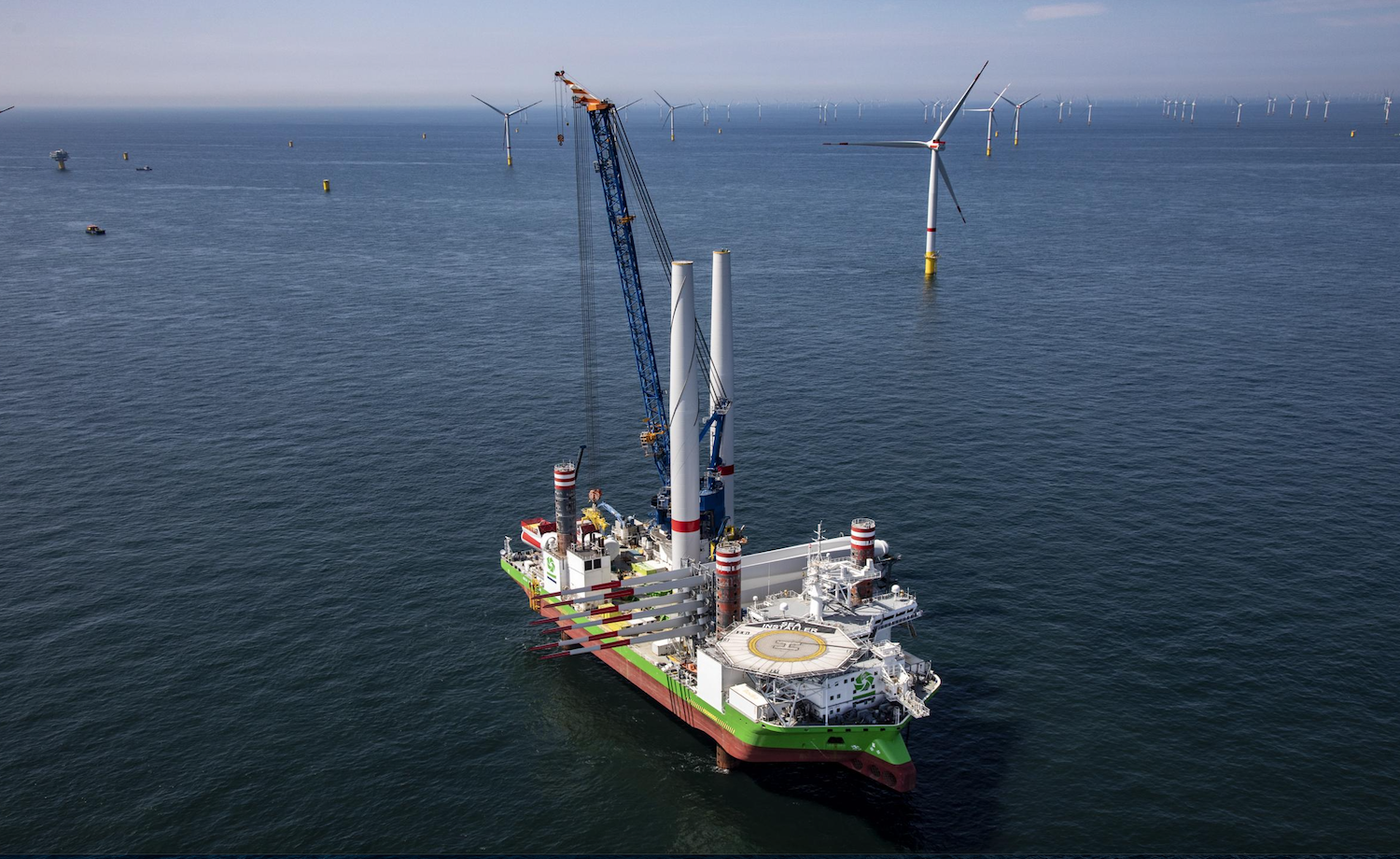Offshore wind developers’ preference for larger, more powerful turbines is outgrowing the global wind turbine installation vessel fleet and demand is expected to outpace supply by 2024, according to a new analysis.
“Operators will have to invest in new vessels or upgrade existing ones to install the super-sized turbines that are expected to become the norm by the end of the decade, or the pace of offshore wind installations could slow down,” says the Feb. 2 report from Norway-based research firm Rystad Energy.
Turbines larger than 8 megawatts were erected in just 3% of global installations between 2010 and 2021, “but that percentage is forecast to surge to 53% by 2030,” according to Rystad.
“When turbines were smaller, installation could be handled by the first-generation fleet of offshore wind vessels or converted jackups from the oil and gas industry. However, as operators continue to favor larger turbines, a new generation of purpose-built vessels is required to meet demand,” said Martin Lysne, Rystad Energy rigs and vessels analyst.
The Rystad report is the latest industry analysis to warn of an imminent WTIV shortfall, which could have big implications and delays for the Biden administration’s drive toward 30 gigawatts of offshore power by 2030
On the same day, ship operator Eneti Inc. abruptly announced it shelved plans with an unnamed U.S. shipyard to build a Jones Act-compliant U.S. flag wind turbine installation vessel.
“We believe the U.S. market for offshore wind will offer significant opportunities for the company in the future, but right now we are focused on delivering on our existing commitments and deriving value from our existing fleet,” said Emanuele A. Lauro, CEO of Eneti in a brief announcement.
Formerly Scorpio Bulkers Inc., the Monaco-based company in August 2020 pivoted its focus to offshore wind and having new WTIVs built in South Korea.
In May 2021 Eneti officials announced their intent to build what would have been the second U.S. flag WTIV – coming behind Dominion Energy’s vessel now under construction. They reiterated that plan in announcing a $200 million sale of Eneti stock to raise capital for vessel projects.
In announcing its change of U.S. plans, the company noted its wholly-owned subsidiary Seajacks UK Limited has secured new wind business in Europe. Seajacks “has signed four contracts with customers in Northwest Europe for between 189 to 240 days of employment for its NG2500-class vessels that will generate between approximately $11.6 million to $14.3 million of revenue in 2022,” according to the Eneti statement. “In addition, the Company announced on Dec, 27, 2021, that the Seajacks Scylla, another vessel of Seajacks UK limited, signed a contract with Van Oord for employment in Europe in 2023. The firm charter duration of the contract will generate approximately $60.0 million of revenue from the first quarter through the fourth quarter of 2023.”
The Rystad report offers a summary of near-term major wind projects with increasing turbine sizes The first commercial 10 MW turbine in European waters was installed in December 2021 at Scotland’s Seagreen offshore wind farm. by Cadeler’s WTIV Wind Osprey. A total of 114 turbines are lined up for the 1.1 GW North Sea project.
At the Vineyard Wind development off southern New England, 13 MW GE Haliade turbines will be installed by DEME’s Sea Installer which is undergoing a crane upgrade. Jan De Nul’s newbuild Voltaire will debut at the Dogger Bank wind farm in the UK, installing 13 MW turbines.
Cadeler is contracted to install 14 MW turbines at the Sofia wind farm in the UK, and 14 MW turbines will also be installed at the Hai Long development in Taiwan.
Off Germany, 15 MW turbines will be installed at the EnBW He Dreiht project, while the U.S. Coastal Virginia Offshore Wind and Empire Wind projects are already planning forward for 15 MW machines.
In the world’s current WTIV fleet, “only a handful of units can install 10 MW-plus turbines, and none are currently able to install 14 MW-plus turbines,” according to Rystad. “This will change towards 2025 as newbuilds start to be delivered and existing vessels get crane upgrades.”
Those include installers Fred Olsen Windcarrier, DEME and Cadeler; their respective vessels Bold Tern, Brave Tern, Sea Installer, Wind Osprey and Wind Orca are in line for upgrading to 1,600-ton cranes between 2022 and 2024, with options for other vessels to be upgraded.
Some turbine manufacturers and project developers are already talking about turbines of 20 MW in the years to come. Rystad notes that too is creating some uncertainty in the market:
“Vessels built early this decade are already becoming outdated as turbines grow, making owners reluctant to commit to expensive newbuilds that could be obsolete before they are profitable. The cost to manufacture an installation vessel capable of installing 14 MW-plus turbines ranges from $300 million to $500 million, but owners are opting for even bigger cranes in the hope of staying competitive for longer.”





